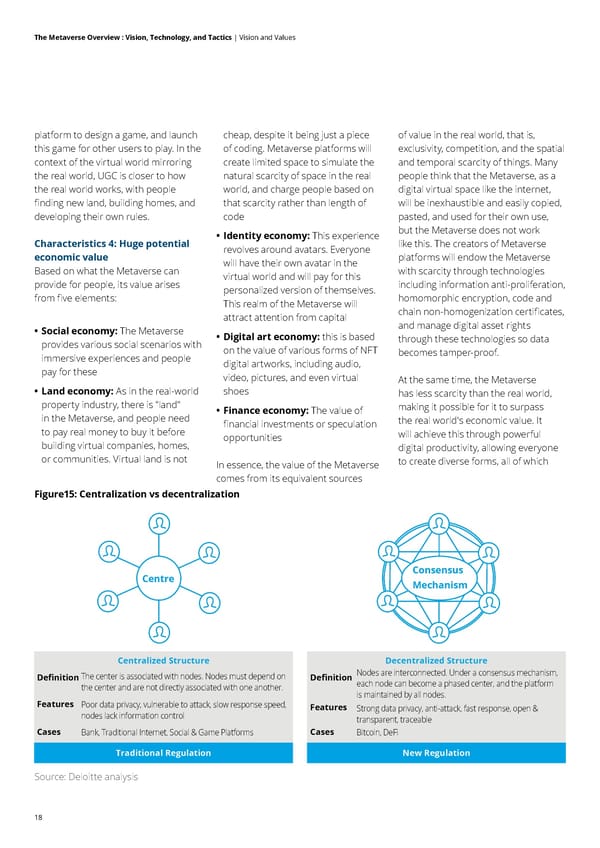18 The Metaverse Overview : Vision, Technology, and Tactics | Vision and Values Figure15: Centralization vs decentralization Source: Deloitte analysis platform to design a game, and launch this game for other users to play. In the context of the virtual world mirroring the real world, UGC is closer to how the real world works, with people finding new land, building homes, and developing their own rules. Characteristics 4: Huge potential economic value Based on what the Metaverse can provide for people, its value arises from five elements: • Social economy: The Metaverse provides various social scenarios with immersive experiences and people pay for these • Land economy: As in the real-world property industry, there is "land" in the Metaverse, and people need to pay real money to buy it before building virtual companies, homes, or communities. Virtual land is not cheap, despite it being just a piece of coding. Metaverse platforms will create limited space to simulate the natural scarcity of space in the real world, and charge people based on that scarcity rather than length of code • Identity economy: This experience revolves around avatars. Everyone will have their own avatar in the virtual world and will pay for this personalized version of themselves. This realm of the Metaverse will attract attention from capital • Digital art economy: this is based on the value of various forms of NFT digital artworks, including audio, video, pictures, and even virtual shoes • Finance economy: The value of financial investments or speculation opportunities In essence, the value of the Metaverse comes from its equivalent sources of value in the real world, that is, exclusivity, competition, and the spatial and temporal scarcity of things. Many people think that the Metaverse, as a digital virtual space like the internet, will be inexhaustible and easily copied, pasted, and used for their own use, but the Metaverse does not work like this. The creators of Metaverse platforms will endow the Metaverse with scarcity through technologies including information anti-proliferation, homomorphic encryption, code and chain non-homogenization certificates, and manage digital asset rights through these technologies so data becomes tamper-proof. At the same time, the Metaverse has less scarcity than the real world, making it possible for it to surpass the real world's economic value. It will achieve this through powerful digital productivity, allowing everyone to create diverse forms, all of which Centralized Structure Definition Features Cases Consensus Mechanism Centre The center is associated with nodes. Nodes must depend on the center and are not directly associated with one another. Bank, Traditional Internet, Social & Game Platforms Poor data privacy, vulnerable to attack, slow response speed, nodes lack information control Traditional Regulation Decentralized Structure Nodes are interconnected. Under a consensus mechanism, each node can become a phased center, and the platform is maintained by all nodes. Bitcoin, DeFi Strong data privacy, anti-attack, fast response, open & transparent, traceable New Regulation Definition Features Cases
 Deloitte The Metaverse Overview Page 17 Page 19
Deloitte The Metaverse Overview Page 17 Page 19